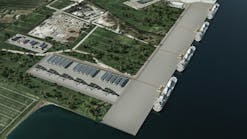Pandemic shopping spree drove Amazon's Carbon Emissions up 18 percent in 2021
Online retail giant Amazon’s ambitious carbon reduction drive got stuck in reverse last year.
The home shopping surge first initiated by the COVID pandemic has stayed in gear and resulted in Amazon’s carbon emissions rising 18 percent in 2021, according to the company’s new sustainability report.
A big part of this was because of the online shopping and home delivery mania, with Amazon creating some 750,000 new full- and part-time jobs globally. Despite the rise in delivery-related emissions overall, Amazon says its carbon intensity dropped by 1.9 percent in a measurement that balances emissions by volume sales of merchandise.
“While we’ve had success cutting emissions from some operations, we are still early in the process of transforming others.” The Amazon sustainability report reads. “Some actions and investments have immediate carbon savings, while others will take years to demonstrate results. The path to net-zero carbon has many obstacles, but we thrive on big challenges.”
Amazon co-founded the corporate Climate Pledge and vows to reach Net-Zero carbon by 2040. The marketplace for nearly everything that can be bought online also plans to either power or off-set 100 percent of its energy use with renewables by 2025.
E-mobility is another method of helping the company reach Net-Zero goals. Amazon is electrifying its delivery fleet and has ordered more than 100,000 EVs from mainly Rivian and also Mercedes-Benz, Stellantis and Mahindra Electric.
“These orders have sent a demand signal that is shifting the market to meet not only our needs, but also the needs of other companies around the world,” the sustainability report reads. “We announced in November that, in the city of Paris, two-thirds of our shipments are delivered using zero emission transport such as EVs, electric cargo bikes, and on-foot deliveries. We also are exploring green hydrogen.”
The online shopping industry shows no sigh of abating soon, so Amazon is also exploring additional ways of cutting carbon emissions from its corporate processes. On the building construction front, it invested in two firms, CarbonCure Technologies and Brimstone Energy, which are innovating ways to reduce emissions in manufacturing concrete and cement, respectively.
Amazon plans to use both CarbonCure and Brimstone Energy products in some of its new construction. Those new buildings will include HQ2, the second Headquarters which will be in Virginia.
“HQ2 will be a model for sustainable construction. We’ve electrified the operations of HQ2, eliminating the use of fossil fuels for buildings systems and food service,” Amazon’s report reads. “We have committed to powering 100% of HQ2’s operations with renewable energy through a combination of off-site and on-site solar projects. And we plan to achieve Leadership in Energy and Environmental Design (LEED) Platinum certification, the highest sustainability building certification issued by the U.S. Green Building Council.
“We also continue to innovate with construction techniques to make our fulfillment centers more sustainable," the statement added. "Many of our fulfillment facilities throughout the U.S., Europe, and India are powered by on-site solar, where a rooftop installation can power up to 80% of the facility’s energy use. As of 2021, 115 of our global fulfillment facilities have rooftop solar installations.”
Renewable energy power purchase agreements are a big part of Amazon’s strategy in off-setting the carbon intensity of its operations. Overall, the company announced 274 global renewable energy projects, including 105 utility-scale wind and solar farms, by the end of 2021.
But, anyway it’s counted, 2021 was a bit of step-back for the company emissions-wise. Even the drop in carbon intensity of 1.9 percent pales compared to the 16 percent decrease achieved in 2020.
The onset of the COVID-19 pandemic and resulting isolation are huge factors in delivery emissions, although it could be counter balanced by a drop in customers driving to shopping centers. Statistics previously released by the U.S. Census Bureau indicates that e-commerce sales elevated well beyond $800 billion annually and rose 43 percent in the first full year of the pandemic.
-- -- --
(Rod Walton, senior editor for EnergyTech, is a 14-year veteran of covering the energy industry both as a newspaper and trade journalist. He can be reached at [email protected]).






